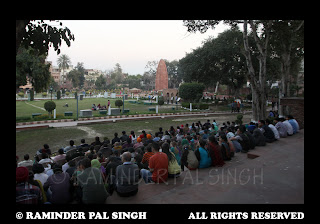Here are a few pictures of what used to be the summer residence of the great Sikh Emperor Maharaja Ranjit Singh. It is situated at the Ram Bagh garden which is also referred to as the Company Bagh by the local people. The old residence was undergoing restoration work when it was photographed here.
Maharaja Ranjit Singh who lived from 13th November 1780 - 27th June 1839 was also called "Sher-e-Punjab" (The Lion of Punjab). He became the first Sikh Emperor, after uniting the 11 Sikh Kingdoms of Punjab together to form an Empire, from 1799-1839.
Maharaja Ranjit Singh was a great warrior, fearless soldier, able administrator, clement ruler, statesman and liberator of Punjab. After several campaigns, his rivals accepted him as their leader, and he united the Sikh factions into one state and he took the title of Maharaja on April 12 1801 with Lahore serving as his capital from 1799.
Maharaja Ranjit Singh stopped India's non-secular style and practices. He treated both Hindus and Muslims equally. He banned the discriminatory religious tax the "jizya" on Hindus and Sikhs which had been imposed by the various Muslim rulers.
Maharaja Ranjit Singh was the first Asian ruler to modernize his army to European standards and was well known for filling the leadership positions in his Darbar with men of varied Religions. People were recognized and promoted on their ability and not their religion.
The Maharaja never forced Sikhism on his subjects. This was in sharp contrast with the attempted ethnic and religious cleansing of past Muslim rulers - Afgani or Mughal. Maharaja Ranjit Singh had created a state based upon Sikhi's noble traditions, where everyone worked together, regardless of their background. One where its citizens looked at the things they shared in common, e.g. being Punjabi traditions, rather than any religious differences.
RAMINDER PAL SINGH ON FACEBOOK
RAMINDER PAL SINGH ON FLICKR
(Text inputs source: http://www.sikhiwiki.org/)
Maharaja Ranjit Singh who lived from 13th November 1780 - 27th June 1839 was also called "Sher-e-Punjab" (The Lion of Punjab). He became the first Sikh Emperor, after uniting the 11 Sikh Kingdoms of Punjab together to form an Empire, from 1799-1839.
Maharaja Ranjit Singh was a great warrior, fearless soldier, able administrator, clement ruler, statesman and liberator of Punjab. After several campaigns, his rivals accepted him as their leader, and he united the Sikh factions into one state and he took the title of Maharaja on April 12 1801 with Lahore serving as his capital from 1799.
Maharaja Ranjit Singh stopped India's non-secular style and practices. He treated both Hindus and Muslims equally. He banned the discriminatory religious tax the "jizya" on Hindus and Sikhs which had been imposed by the various Muslim rulers.
Maharaja Ranjit Singh was the first Asian ruler to modernize his army to European standards and was well known for filling the leadership positions in his Darbar with men of varied Religions. People were recognized and promoted on their ability and not their religion.
The Maharaja never forced Sikhism on his subjects. This was in sharp contrast with the attempted ethnic and religious cleansing of past Muslim rulers - Afgani or Mughal. Maharaja Ranjit Singh had created a state based upon Sikhi's noble traditions, where everyone worked together, regardless of their background. One where its citizens looked at the things they shared in common, e.g. being Punjabi traditions, rather than any religious differences.
RAMINDER PAL SINGH ON FACEBOOK
RAMINDER PAL SINGH ON FLICKR
(Text inputs source: http://www.sikhiwiki.org/)
















